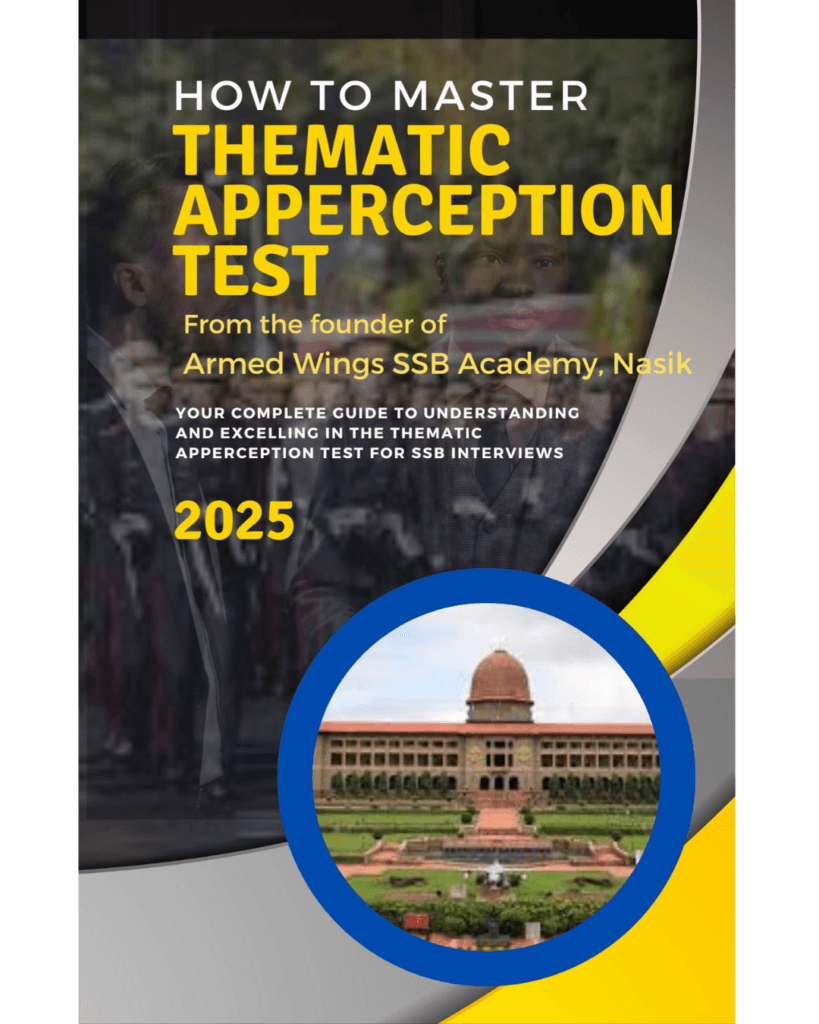
Chapter One-How To Master Thematic Apperception Test
In this first chapter, you will learn about the concept, science & mechanism behind the Thematic Apperception Test.
How This Book Will Help You Master Thematic Apperception Test
This book has been designed with one clear objective: to help you deeply understand the art and science of writing powerful, meaningful stories for the Thematic Apperception Test (TAT) — a test that remains one of the most crucial and complex elements in the SSB psychological testing process. With 50 carefully curated chapters across 344 pages, this book provides not just examples, but detailed psychological analysis and hidden insights that are especially crucial for repeaters.
Many repeaters struggle not because they lack writing skill, but because they unknowingly carry forward flawed patterns in their stories — patterns that go unnoticed in coaching institutes but stand out sharply in the eyes of trained assessors. This book directly addresses that problem.
The entire book is divided into five focused sections spread over 50 Chapters and 344 pages — each section revolving around detailed concepts related to TAT which will help you develop your skills in TAT immensely. For each image, multiple stories are presented and then dissected with an assessor’s lens. These aren’t model answers for memorization. Each chapter re-trains your thinking, showing how a seemingly “good” story can create a poor impression, while a more honest and structured one can convey leadership, maturity, and emotional depth.
A common mistake repeaters make is believing they already know what the board wants. This book breaks that illusion. You’ll finally understand why stories that appear ideal on the surface often carry deep psychological red flags — and how to fix that. You’ll uncover what the board is actually looking for — and how to align your thoughts with it.
Dedicated chapters also teach you how to write a story from scratch, develop clarity and originality, and avoid common traps. You’ll learn to use keywords, structure, emotional intelligence, and relevance to create stories that are both impactful and acceptable.
What makes this book a game-changer for repeaters is its depth of comparative analysis. You’ll see how a story can be slightly tweaked to convey stronger officer-like qualities — without losing your authenticity. You’ll finally be able to answer the question: “Why didn’t I get recommended, even though my story felt right?”
By the end, you won’t just learn to write stories. You’ll develop a deep, insider-level understanding of how assessors interpret your work — and how to avoid repeating mistakes from previous attempts. Whether you’ve faced multiple conferences without success or you’ve just realized your stories aren’t working, this book is your breakthrough.
Below is a detailed listing of the first 9 chapters of this book which have been made available on this website for free. Chapter 1 can be read by scrolling to the second half of this page.
Chapter 1: The Hidden Logic Behind TAT Images-Most repeaters assume TAT images are random — but that’s exactly where many go wrong. This chapter reveals the psychological design behind each image and how they are silently testing your OLQs. Learn why your stories may have failed not because of language, but because you misread the very foundation of the image. A must-read before attempting even one story again.
Chapter 2: How to Truly See a TAT Image-You may have seen dozens of TAT images before — but have you ever seen them the way assessors do? This chapter teaches you to break free from past habits and see through the lens of Figure, Background, and Stimulus. If your earlier attempts lacked direction or felt generic, this chapter will rewire your approach and give your stories clarity and originality.
Chapter 3: Building Stories That Get You Recommended-If your stories have always felt “decent” but never led to a recommendation, this chapter is for you. It goes beyond content and dives deep into structure — showing how the right sequence, pacing, and flow can elevate your entire story. Learn how top candidates build narratives that subtly showcase OLQs — and why most repeaters miss this entirely.
Chapter 4: Mastering Image Perception-Repeaters often rush into writing without truly decoding the image. This chapter walks you through the perceptual process of trained assessors. Using a real TAT sample, you’ll see how much detail you’ve likely missed before — and how to train yourself to read what’s not obvious. A critical reset for those who’ve written many stories but feel they’re going in circles.
Chapter 5: Inside the Mind of the Assessor-You’ve written stories before — but do you know how they were read? This chapter gives you a rare window into how assessors dissect every word. Based on a real story written by a serving IAF candidate, it shows how tiny details can trigger major judgments. If you’ve ever wondered why you weren’t recommended, this chapter may finally answer that.
Chapter 6: A New Story, A New Lens-Here’s your chance to explore a fresh TAT response from another IAF aspirant — with different strengths and different flaws. This chapter is especially helpful for repeaters who think “there’s only one good way to write a story.” You’ll learn that multiple angles can work — if interpreted correctly — and how to evolve your own voice without losing psychological accuracy.
Chapter 7: Inside the Mind of an Army Aspirant-This real story from a serving Army candidate reveals how even small changes in tone or direction can shift your assessment. Ideal for repeaters, this chapter shows what you might have done wrong — and how to fix it, with clarity. Learn how minor blind spots in your stories could be creating major perception issues.
Chapter 8: Transforming a Story—The Power of Precision-If you’ve ever written a story and felt, “It was close, but something was missing,” this chapter shows you what that something is. Watch how the story from Chapter 7 is transformed with sharper expression, intent, and psychological alignment. This chapter is pure gold for repeaters aiming to refine their work instead of starting over.
Chapter 9: Building Your TAT Skills—A Practical Guide-By this stage, you’ve seen what works, what fails, and why. This final chapter ties everything together into a step-by-step method you can apply right away. Designed for repeaters looking to rebuild confidence and strategy, this guide helps you set clear goals, track your improvement, and prepare smarter — not harder — for your next attempt..
Chapter 1: The Concept, Science & Mechanism Behind Thematic Apperception Test
(This is Chapter 1. To read Chapter 2, click on the button at the bottom of the page)
In this first chapter, we’ll understand the science, concept and mechanism behind Thematic Apperception Test. In the process, we will also understand how Thematic Apperception Test images are designed to gauge qualities in the candidates. We all know that all the tests which you undergo during the 5-day SSB process are gauging certain qualities in you. Those qualities are divided into four categories, each of which is called a factor. So namely you have factor 1, factor 2, factor 3 and factor 4.
Under factor 1 you have qualities like effective intelligence, reasoning ability, organizing ability and power of expression. These qualities, as you can understand, mainly relate to your mental faculty. Effective intelligence generally relates to your ability to do your day-to-day work properly. Reasoning ability relates to whether there is a proper logical reason behind what you think and what you do. Organizing ability relates to whether you are able to execute a task properly in a systematic manner if you are given certain resources and a certain time frame to do it. Power of expression mainly relates to whether you are able to express yourself verbally or in a written form in a very clear manner in such a way that it leaves no room for any kind of a confusion or discrepancy in the other person’s mind. All these qualities come under factor 1.
Then under factor 2 you mainly have qualities which relate to social behaviour or what can be called group behaviour. So, you have qualities like social adaptability. Social adaptability mainly relates to how quickly and easily you mingle up amongst a group of people or in a cultural environment which is not your own, and more importantly how
1
quickly and easily the group of people from other cultural backgrounds accept you. For instance, if you are a person who is born and raised in Haryana and if you are sent to Kerala, let us say on a posting, how quickly and easily will you mingle up amongst the people there and more importantly, how quickly and easily will the people there accept you? The other important qualities under factor 2 are cooperation and sense of responsibility. Those are self-explanatory terms. These are the main, but not the only qualities, which come under factor 2.
Under factor 3 you have qualities like initiative, again a self-explanatory term. If there is a task at hand which nobody else would like to do, either because it is too difficult or of an unpleasant nature, for example cleaning garbage, then will you come forward to do it. The next quality under factor 3 is self-confidence which is again a self-explanatory term. Next important quality is speed of decision. This is particularly important under stress. When there is an emergency or crisis at hand, are you able to take the right decision quickly? The next important quality is ability to influence a group. Are you having the kind of personality which others will believe in very easily and which others will follow? It is one of the key qualities of a leader. The next important quality is liveliness. How lively are you? Have you done anything in life apart from the routine mandatory things? It is precisely to check your liveliness that during interview your hobbies and interests are checked in a very thorough manner. If you are a person who has not done anything apart from the routine mandatory things then you lack liveliness. In which case it is believed in psychology that even during emergency you will not respond quickly because you are a person who is not having that level of energy. These are some of the important qualities under factor 3.
2
Then under factor 4 you have qualities like determination. It is a self-explanatory term. The next important quality under factor 4 is courage-both physical as well as moral. Physical courage means can you fight in Kargil? Moral courage means let us say tomorrow, if a high-ranking officer is sexually harassing a lady officer, will you go ahead and stop him or will you worry about your own ACRs, your promotions and your future and let him do what he wants. Stamina-both mental as well as physical. What is physical stamina? If you can run 5 kms it shows you have good physical stamina. What is mental stamina? If you can read a 500 page book if you can sit and practice guitar for one hour every day for the next 2-3 years then it shows you have good mental stamina and it also shows love for learning. That is why if you are a person who loves to read books or someone who has learnt a musical instrument, it will benefit you a lot in SSB because it will show that in the future you will not be tired of learning and undergoing courses. That is why these kind of qualities are being gauged in you.
Most of the candidates do not know that the images which come to you during your thematic apperception test predominantly belong to one of these factors. The images which come to you are a mixed bag. Out of the images which come to you, 2 or 3 belong to factor 1, 2 or 3 belong to factor 2, 2 or 3 belong to factor 3 and 2 or 3 belong to factor 4.
What kind of an image will come under factor 1? To check your factor 1, one of the most common images that comes in the thematic apperception test is shown as an example in figure 1.1 in which a boy is shown studying under a lamp.
3
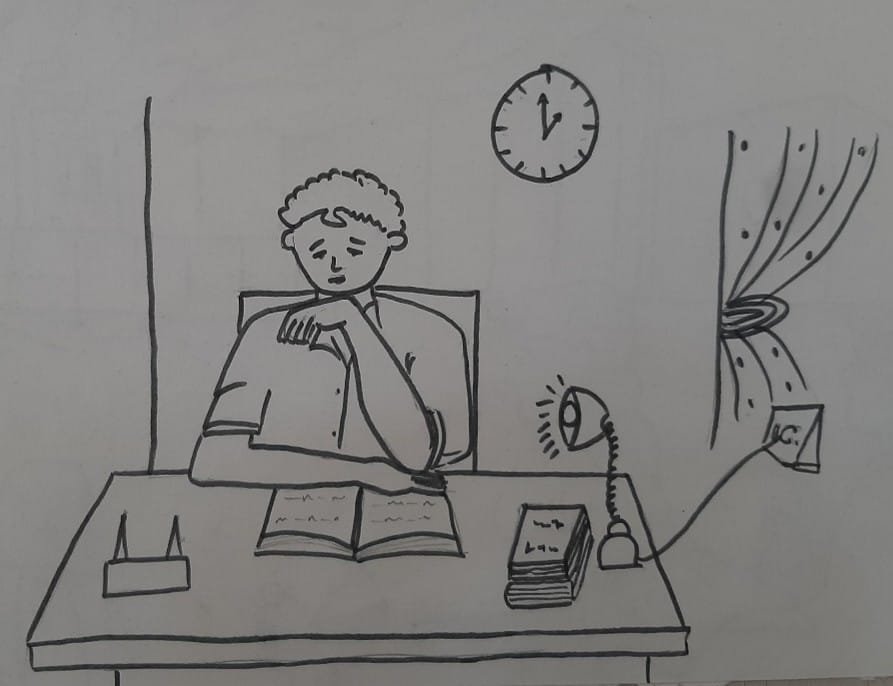
Figure 1.1
In figure 1.1 above, there is a boy studying under a lamp. The very fact that the lamp is on shows he is studying till late night. Nobody needs a lamp during daytime. At times there is also a wall clock shown in the background having the time being displayed as 1 o’clock in it. It takes common sense to understand that if it is 1 pm then he won’t be keeping the lamp on. So definitely he is studying till late night for something. Studying till such late hours also shows that he is working with lot of determination and efforts. He might be preparing for 10th board/12th board/NDA written/IIT-JEE, NEET or any such exam. What is he preparing for & how will he go about it is what will reflect his organizing ability and his work sense. That is why, in the thematic apperception test, this kind of an image belongs to factor 1.
4
Then what kind of an image will come under factor 2? One of the most common examples I can give is of an image which you can see in figure 1.2.
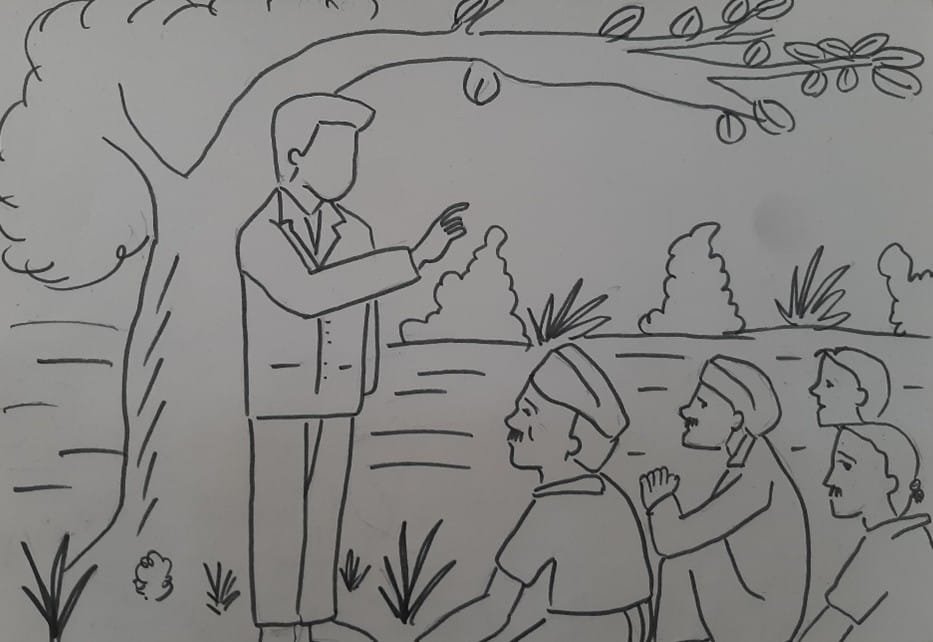
Figure 1.2
In the image shown in figure 1.2, you can see a boy who is very well dressed. He is wearing a blazer and is nicely dressed. Hair combed nicely. He is wearing formal shoes. The way he is dressed makes it look like he is a well-educated urban young man who is probably financially also in a very stable position if not very strong. He is standing under a tree and talking to a group of villagers. How you can understand that they are a group of villagers? The way they are dressed gives a clear indication of the fact that they are villagers. Some of them are wearing a Gandhi topi. Some are wearing a pagdi. Most of them are wearing a dhoti. All this clearly implies that they are villagers. So, he is a person who is interacting with a group of people who do not belong to his
5
background. What is he doing there? How comfortable he is with them? Will he be able to get his work done? How you write about these points in the thematic apperception test story will show whether your own factor 2 is strong or not.
Let us discuss what kind of an image will come under factor 3? Generally, images which relate to an emergency or where there is life at risk come under factor 3. So, under factor 3, you generally have images like that of an accident or of a building on fire. How you write the story will help the assessor understand whether your own factor 3 is strong or not. Figure 1.3 and figure 1.4 show examples of images which come to check factor 3 in the thematic apperception test.
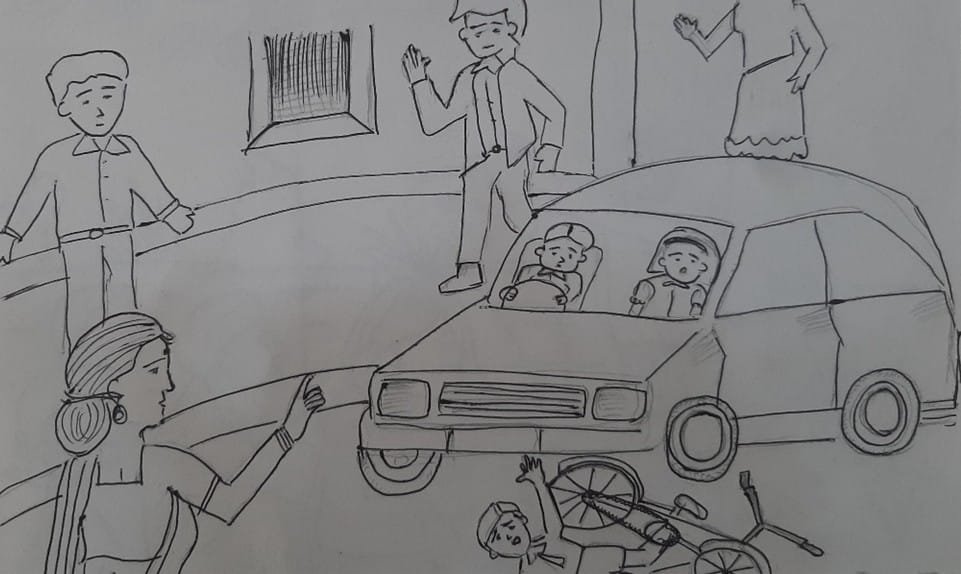
Figure 1.3
6
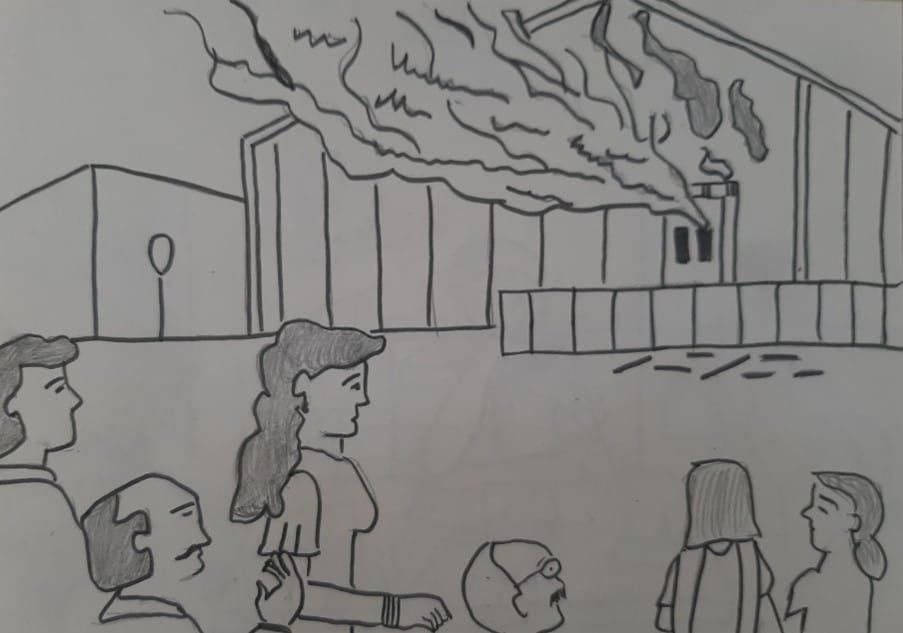
Figure 1.4
Under factor 4, you mainly have images in which a group activity or an activity which takes a long concerted effort is visible. For example, two people running, a group of people playing football or a person playing a musical instrument. These types of images relate to factor 4. Games like football involve physical stamina and I have already explained earlier that physical stamina comes under factor 4. Learning and practising a musical instrument over a long period of time shows mental stamina and I have already explained earlier how mental stamina comes under factor 4.
I am sure now you understand how the images which come during the thematic apperception test belong predominantly to one of the four factors. In the next chapter I will help you understand how to view and analyse an image and what should be the structure of the story.
What if the key to writing a high-scoring TAT story isn’t in your imagination—but in the image itself? Click Here to Read the next chapter to learn how to spot what 90% of candidates overlook.
Want to crack SSB Psychology with deeper clarity? Check out the first 10 chapters of our SRT book by clicking here and first 10 chapters of our WAT book by clicking here — available free on the website.
7
